
Slackdhu - 496m
Friday 22nd May 2009
Friday 22nd May 2009
 Weather/Conditions: Warm and sunny, with a bit of a breeze higher up. A very nice day to be walking.
Weather/Conditions: Warm and sunny, with a bit of a breeze higher up. A very nice day to be walking.
Distance/Ascent/Time: 6km / 400m / 2h 40m
Accompanying: Alone mostly, but with Steve to start with
With the sun beating down, it was a warm afternoon but I was slightly glad to be exploring some new ground, as opposed to following established routes. I climbed up to a vertical cleft in the rock, a striking feature especially visible from below. Having reached the cleft, I searched out routes up and around about it, but the rock was unstable, too dangerous to make any scramble. I may have been able to climb some of these cliffs, but the commitment to do so was far too high. Instead, I followed a ramp to the left hand side of the cliff. It too was a scramble, but easier to climb than any rock face.
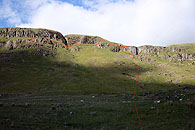
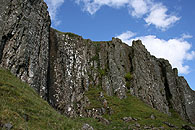


From here I traversed the hillside, east to west, heading in the direction of the cliff bands. This route and all it's offshoots are visible in the first image. I was following this route when I came upon pebbles and stones partially buried within the surrounding rock and for me to explain this fully, a little background info is in order about the area's geology. The Campsie Fells are comprised of basalt, which is magma that has been ejected from the ground by a volcano and cooled on the surface. In the case of the formation of the Campsies, it cooled in flat sheets and subsequent erosion exposes the various eruptions as cliffs bands. The lower down the layer of basalt, the older it is, because each layer forms on top of the last. The younger rock therefore lies towards the summits. What I came across were smoothed stones eroding out from the cliff face and this suggests to me that once upon a time, these rocks (which once lay in open air) were overcome by lava, and it is only now, over 100 million years on (I believe...) that they are finally reappearing back into the open air.
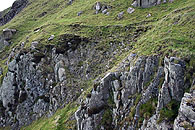
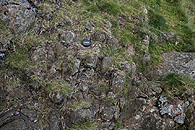

But that's the geologist in me coming out, an interest that I've developed recently. From this area of stones, I had a look around the cliffs, including one prominent gully that was of interest. It was a little too committing to scramble up, for the crumbling rock, potential long line of fall, dampness and vegetation. I took the easy route around the side, and climbing down the gully from the top showed me that there was one 'crux' to climbing up here: a one meter high step in the gully, with crumbling rock around about and water flowing down. It wouldn't make the best scramble.
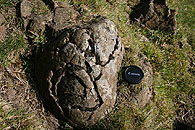

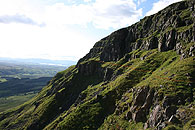
Now I was almost up on the plateau, but didn't have the motivation to climb the final section up to the summit. Instead of summiting now, I followed the cliff bands around the hillside until I arrived at 'Black Craig', (as marked on OS 1:25000) the main area of cliffs on Slackdhu. Recently, I've been ascending via the side of Black Craig, although today I took things a step further and followed sheep trails across the cliff bands. Brilliant exposure, cliffs and boulders beneath me. A fall would be disastrous, but I needn't think about that, because I really felt fine. Thanks to Slackdhu, I have been making myself well accustomed to exposure.

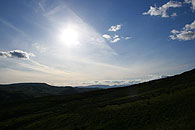
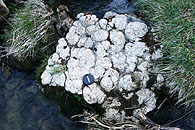
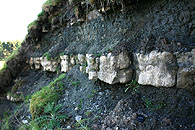
Half way across the cliff bands I stopped at a ledge where going further may have been riskier. I didn't have a mobile phone and was alone, so once again, it was a question of commitment. I doubled back on tracks and took an easy route to Slackdhu where I arrived at it's summit at 6.45pm. On descent, my heightened 'immunity' to exposure presented itself well. I was eager to catch the 7.40pm bus in Strathblane as there would be no buses for another two hours. This would leave me about fifty minutes to get off the hill, and as a result I followed a steep route of ascent I'd taken before, a route I'd been edgy about going up, nevermind going down. Today, I down climbed it with ease, proving to myself that I was moving far more confidently than before. It's nice to see progress.
On flatter ground below, I walked through the sprouting bracken, reminding myself that it will likely cut accessibility to this hill in summertime when it becomes difficult to walk though. I walked back to the river and got back to Strathblane at 7.30pm in good time to make the bus.
Panoramas

Southern Highlands

Campsies
Written: 2009-05-23